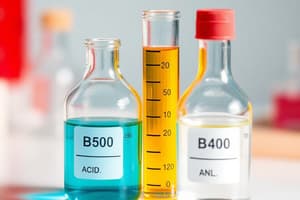Podcast
Questions and Answers
Which characteristic defines acids?
Which characteristic defines acids?
- Release of hydrogen ions when dissolved in water (correct)
- Bitter taste
- Turn blue litmus paper red
- Ability to accept protons
What is the role of indicators in chemistry?
What is the role of indicators in chemistry?
- Change color in response to changes in pH (correct)
- Ionize completely in aqueous solution
- Form salts and water
- React with bases
Which acid is known for its presence in vinegar?
Which acid is known for its presence in vinegar?
- Acetic acid (CH3COOH) (correct)
- Nitric acid (HNO3)
- Hydrochloric acid (HCl)
- Sulfuric acid (H2SO4)
What is the result of a neutralization reaction between an acid and a base?
What is the result of a neutralization reaction between an acid and a base?
Which base is commonly known as caustic soda?
Which base is commonly known as caustic soda?
What defines a strong acid in aqueous solution?
What defines a strong acid in aqueous solution?
What distinguishes bases from acids?
What distinguishes bases from acids?
What does litmus paper turn into when in basic or neutral solutions?
What does litmus paper turn into when in basic or neutral solutions?
What happens to pH during a neutralization reaction?
What happens to pH during a neutralization reaction?
What distinguishes weak acids from strong acids?
What distinguishes weak acids from strong acids?
Study Notes
Exploring Acids and Bases
Understanding Acids
Acids are substances that release hydrogen ions (H+) when dissolved in water. They are characterized by their sour taste and ability to react with bases. A strong acid is a substance that ionizes completely in aqueous solution, while a weak acid ionizes only partially. Acids are involved in many chemical reactions, playing a crucial role in maintaining the pH balance of the human body and other living organisms.
Examples of Acids
- Hydrochloric acid (HCl)
- Sulfuric acid (H2SO4)
- Nitric acid (HNO3)
- Acetic acid (CH3COOH)
- Citric acid (C6H8O7)
Understanding Bases
Bases are substances that accept protons (H+) from other substances, such as acids. They are characterized by their bitter taste and ability to react with acids. A strong base is a substance that ionizes completely in aqueous solution, while a weak base ionizes only partially.
Examples of Bases
- Sodium hydroxide (NaOH)
- Calcium hydroxide (Ca(OH)2)
- Ammonia (NH3)
- Vinegar (CH3COOH)
Understanding Indicators
Indicators are substances that change color in response to changes in pH. They are used to determine the strength of an acid or a base. For example, litmus paper turns red in acidic solutions and blue in basic or neutral solutions.
Understanding Neutralization
Neutralization is the reaction between an acid and a base, resulting in the formation of a salt and water. It is a process that is reversible and can be illustrated by the following reaction:
Acid (H+) + Base (OH-) → Salt + Water
Example of Neutralization
- Acetic acid (HAc) + Sodium hydroxide (NaOH) → Sodium acetate (NaC2H3O2) + Water
Neutralization in Everyday Life
Neutralization reactions are common in everyday life, such as the use of toothpaste, which is alkaline and helps neutralize acids in the mouth to protect teeth from damage.
Studying That Suits You
Use AI to generate personalized quizzes and flashcards to suit your learning preferences.
Description
Test your knowledge on acids, bases, indicators, and neutralization reactions with this quiz. Learn about the properties of acids and bases, examples of common acids and bases, how indicators work, and the process of neutralization. Explore the importance of these concepts in chemistry and everyday life.




